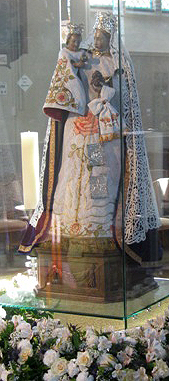Saturday after the Third Sunday
Onze-Lieve-Vrouw van Westrozebeke, Staden, West Flanders, Belgium
 On November 26, 1382, opposing armies camped around the village of
Westrozebeke: rebels recently victorious in Ghent vs. Louis II, King of Flanders
and French troops brought in to help him. Area residents congregated at a forest
chapel to beg the Virgin's help. At the battle the next day, the rebels fled
after their leader was killed. Afterward, the story goes, people discovered a
red silk thread encircling the area the King's forces had occupied, with seven
knots equally spaced along it, and crosses where the ends met: a sign of the
Virgin's protection. This was soon distributed for relics, and in its place
eight chapels were built: seven to honor each of Mary's Sorrows, where the knots
had lain, and a larger one to honor the Holy Cross. In 1384, Louis II's
son-in-law Philip II of Burgundy instituted an annual procession and mass in
thanksgiving for the victory.
On November 26, 1382, opposing armies camped around the village of
Westrozebeke: rebels recently victorious in Ghent vs. Louis II, King of Flanders
and French troops brought in to help him. Area residents congregated at a forest
chapel to beg the Virgin's help. At the battle the next day, the rebels fled
after their leader was killed. Afterward, the story goes, people discovered a
red silk thread encircling the area the King's forces had occupied, with seven
knots equally spaced along it, and crosses where the ends met: a sign of the
Virgin's protection. This was soon distributed for relics, and in its place
eight chapels were built: seven to honor each of Mary's Sorrows, where the knots
had lain, and a larger one to honor the Holy Cross. In 1384, Louis II's
son-in-law Philip II of Burgundy instituted an annual procession and mass in
thanksgiving for the victory.
The annual pilgrimage continued for centuries. People from the provincial capital, Bruges, brought new clothes for Our Lady's statue, while those from Menen, to the south, came in thanksgiving for their deliverance from an epidemic in the early 1500s.
In 1566, iconoclasts destroyed the statue. Believers installed a new one in 1584.
During World War I, another miracle came to light. In 1916, when Germans torpedoed the ferry Sussex as it crossed the English Channel toward France, sailors from Westrozebeke prayed to Our Lady and were spared. But their village was not so fortunate: it was destroyed during the war. Our Lady's beloved statue, which had been moved away for safekeeping, returned afterwards and was installed in the new Church of St. Bavo on June 13, 1924.
Now part of the municipality of Staden, Westrozebeke holds a 10-day festival in July, starting on the third Sunday, when firemen throw roses from the church tower. The religious portion culminates in Our Lady's Pageant on the following Saturday, with a procession and mass in St. Bavo's Church, where roses encircle the statue of Our Lady in a glass case.
Sources include:
| "Bedevaart naar O.L.Vrouw van Westrozebeke," www.jojo-menen.be/jojomenen/bedevaart_westrozebeke.html (photo) | |
| "Kermis," www.staden.be/WWW/gemeente/3654.html | |
| Otto, Baron de Reinsberg-Düringsfeld, Traditions et légendes de la Belgique, Tome 2, Ferdinand Claassen, Brussels,1870, classiques.uqac.ca/classiques/reinsberg_duringsfeld_baron/traditions_belgique_t2/traditions_t2.html | |
| "Sint-Baafskerk Westrozebeke (B-8840)," Kerken in Vlaanderen, www.kerkeninvlaanderen.be/pages/kerk_01530.htm | |
| "Westrozebeke," Wikipedia, nl.wikipedia.org/wiki/Westrozebeke |